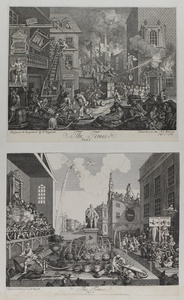| Method | Copper engraving and etching |
| Artist | William Hogarth |
| Published | Designed & Engraved by W Hogarth/Published as the Act directs Sepr: 7 1762 / Designed & Engraved by W. Hogarth./Publish'd May 29: 1790, by J. & J. Boydell, Cheapside, & at the Shakspeare Gallery Pall Mall London |
| Dimensions | Images 240 x 300 mm and 250 x 300 mm, Album Sheet 645 x 475 mm |
| Notes |
A pair of plates laid to the same album sheet, from the first Boydell printing of Hogarth's works, entitled 'The Times: Plate 1' and 'The Times: Plate 2,' satirising the recent resignation of William Pitt and the continuance of the Seven Years War, and showing support for the new ministry of the unpopular Earl of Bute. The Boydells purchased Hogarth's plates from the estate of his widow Jane in 1789, issuing their first folio on thick laid paper they had purchased along with the rest of Hogarth's stock. Plate 1: The scene is set in a London street. The Seven Years War has been characterised as a destructive raging fire, which sets alight one side of the street. William Pitt is depicted on stilts, the crutches that he used during his bouts of gout, fanning the flames with a large bellows. A millstone with the inscription '3000£ per annum,' Pitt's pension, hangs from his neck. The fire blazes through a large globe that sits above the ornamental lintel of the building's door, illustrative of the international nature of the conflict. Down the street behind Pitt, the aggressor nations are depicted as houses already in flame. The fleur-de-lis hangs outside one, indicating France, the double-headed eagle of Germany next door. Across the street another sign shows a Frenchman and a Spaniard clasping hands in agreement. At the centre of the scene, King George (or one of his representatives), identified by the 'GR' badge on his arm, stands atop a fire engine of the Union Office and attempts to fight the fire. He is doused by his political opponents in the 'Temple Coffee House,' who turn their hoses on the King rather than on the more pressing danger of the fire across the street. The faceless man is identified as Pitt's supporter and brother-in-law, Earl Temple, criticised as having no political personality of his own beyond supporting Pitt's wishes. In the foreground to the left, the Mayor of London, Alderman William Beckford, another Pittite, gestures to a cartoon of a Native American Indian, who carries bags of money and stands before barrells of West Indian Tobacco and Sugar, the source of Beckford's Wealth. Before him, another Pittite pushes a barrow of pro-Pitt propaganda towards the flames, ramming a loyal Highlander who rushes to help with buckets of water. To the right of these, a group of German paupers gather around Frederick the Great, who plays his fiddle while London burns. Paulson 211 iii/iii, BM Satires 3970 Plate 2: The scene now is one of peace, with the fire of War having been extinguished. Where Plate 1 had King George atop a fire-engine, Plate 2 now has a statue of the King atop a pedestal in the centre of a fountain, which has replaced the streams of the firehoses in the previous scene. The fountain now waters a series of trees, representing those with royal support. A large vase with a tree marked 'Culloden' is the only one not receiving water from the fountain, a representation of the unpopularity of the Duke of Cumberland in the aftermath of the Battle of Culloden. The rainbow in the sky, decorated with the signs of the zodiac, takes pity on the unwatered tree, with Aquarius emptying his waterjug over it. Bute is depicted at the forefront, manning the pump that supplies water to the fountain. Behind him, the assembled Lords and Commons are divided into two parties, one supporting War, the other Peace. The Peace party, negligently asleep in their seats, are unaware of the actions of the War Party, who fire muskets at the dove of peace, which flies through the sky at centre clutching an olive sprig. The man who turns his head away from his shot is William Pitt, identified by the large flannel wraps around his gout-ridden legs. On the right of the plate, two figures are pilloried for 'Conspiracy' and 'Defamation.' The woman on the left is Ms. Fanny, the perpetrator of the Cock-Lane Ghost fraud. She is dressed as the ghost, carrying a mallet, used for making knocking noises, and a candle, which threatens to set alight the pamphlet of her colleague in the pillory, the notorious radical and libertine, John Wilkes. A young boy urinates on Wilkes' shoes, while a group of crippled war-veterans mill around a small culvert. Paulson 212 iv/iv, BM Satires 3972 William Hogarth (1697 - 1764) was born in London, the son of an unsuccessful schoolmaster and writer from Westmoreland. After apprenticeship to a goldsmith, he began to produce his own engraved designs in about 1710. He later took up oil painting, starting with small portrait groups called conversation pieces. He went on to create a series of paintings satirising contemporary customs, but based on earlier Italian prints, of which the first was The Harlot's Progress (1731), and perhaps the most famous The Rake's Progress. His engravings were so plagiarised that he lobbied for the Copyright Act of 1735, commonly referred to as 'Hogarth's Act,' as a protection for writers and artists. During the 1730s Hogarth also developed into an original painter of life-sized portraits, and created the first of several history paintings in the grand manner. Condition: Excellent impressions, printed on thick laid paper. Trimmed within platemarks, without loss to images or inscriptions, and laid to thick wove paper album page. Waterstaining to bottom of album page, not affecting laid sheets. |
| Framing | unmounted |
| Price | £300.00 |
| Stock ID | 50684 |

